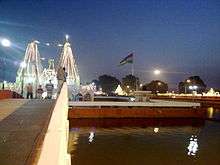Brahma Sarovar
| Brahma Sarovar | |
|---|---|
 | |
| Location | Thanesar, Haryana |
| Coordinates | 29°58′N 76°50′E / 29.96°N 76.83°ECoordinates: 29°58′N 76°50′E / 29.96°N 76.83°E |
| Basin countries | India |
| Max. width | 1,800 ft (550 m) |
| Surface area | 1,400 ft (430 m) |
| Max. depth | 45 ft (14 m) |
Brahma Sarovar is an ancient water tank sacred to Hinduism in Thanesar, in the state of Haryana in North India.[1] Hinduism lays emphasis on taking bath for internal and external purity. Most religious sites have water tanks or sarovar in or near the temple/gurdwara.
History
According to stories of myths, Lord Brahma created the universe from the land of Kurukshetra after a huge yajna. The Brahma Sarovar here is believed to be the cradle of civilization. The sarovar is also mentioned in the eleventh century AD memoirs of Al Beruni, called ‘Kitab-ul-Hind’. The sarovar also has a mention in Mahabharata citing its use by Duryodhana as a place for hiding himself under water on the concluding day of the war.
A sacred shrine dedicated to Lord Shiva stands within the sarovar, accessible by a small bridge. According to scriptures, bathing in this sarovar increases the sanctity of performing the ‘ashvamedh yajna’. The tank offers a breath-taking sight during the Gita Jayanti celebrations held in the last week of November and early December every year when there will be ‘deep daan’ and ‘aarti’. This also happens to be the time when migratory birds from distant places wing it to the sarovar. The Birla Gita Mandir and Baba Nath’s haveli and temple are the neighbouring attractions.


At Present
The historic Brahma Sarovar has been renovated with modern facilities and pathways. It is 3600 feet long and 1500 feet broad and is in the shape of perfect rectangular. The tanks are especially crowded during solar eclipse because it is believed that a dip there during the solar eclipse absolves one of all sins. It is considered as one of the largest man-made ponds.
Solar eclipse ritual
About 10,00,000 people visited the lake and took a dip in the water on 29 March 2006 which was a solar eclipse day.[2] During every solar eclipse day, lakhs of people take dip during the eclipse time as well as during the entire day and pray for sun god.[3] One of the most delightful occasions is the Gita Jyanti celebrations held in the last week of November or the first week of December. The tank presents breath-taking spectacle of Deep daan (ceremony of floating lamps in water) and Aarti organized on this occasion. All around the world participates at this occasion. We can see a big crowd at these occasions.
Bibliography
- Jagmohan (2005). Soul and Structure of Governance in India. Mumbai: Allied Publishers.
- Kamran, Krishnam (1997). Tourism: Theory, Planning, and Practice. New Delhi: Indus Publishing.
- (2006). "Kurukshetra Calling." The Statesman (India). September 5.
- Prasad, Ramanuj (2005). Know Your Puranas. Delhi: Pustak Mahal.
References
- ↑ "Religious Places in Kurukshetra - Brahma Sarovar". Kurukshetra district website. Retrieved 2014-08-08.
- ↑ United New of India (29 March 2006). "Lakhs take dip in Brahma Sarovar on Occasion of Solar Eclipse". oneindia.in. UNI. Retrieved 25 October 2014.
- ↑ Dutt, K.G. (23 August 1998). "Three hundred thousand take holy dip". The Tribune India. Retrieved 25 October 2014.